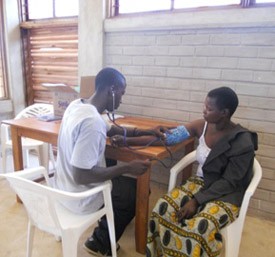
UC Design Effort Resulting in Tanzanian Health Clinic Wins National Recognition
Until recently, anyone wanting medical care in the Tarime region surrounding the community of Roche, Tanzania, had to walk for miles to reach the nearest city. That included women in labor or people with serious injuries.
Because of the need for medical facilities in that area combined with challenges related to the site University of Cincinnati faculty and students in the College of Design, Architecture, Art, and Planning (DAAP), the College of Medicine and the College of Engineering & Applied Science, as well as project sponsor
and others, worked together over several years to design a health center that was then built by the local community and includes features like earthquake-resistant masonry, natural cooling methods and more. The facility opened on April 1, 2011.
In all, UC faculty and students worked both in classroom settings and studios and on site for three years in order to help make the clinic a reality. Last year, the project won
from the National Council of Architectural Registration Boards (NCARB), an organization that oversees the licensure of architects, and on March 2, the project will be one of three recipients of the 2011-2012 ACSA (American Collegiate Schools of Architecture) Collaborative Practice Award which honors the best practices in school-based community outreach. Accepting the ACSA award on behalf of the project team will be Michael Zaretsky, assistant professor in UCs School of Architecture and Interior Design, part of the College of Design, Architecture, Art, and Planning.
Said Zaretsky, The best part of receiving this award is the fact that its coming from an educational body after the project has already received national recognition from an organization of architectural practitioners. That means the work succeeded in combining architecture practice and education. Its being recognized on both fronts, and we here at UC are appropriately engaging practice and academia.
As part of the Collaborative Practice Award, the UC humanitarian design project details will be published in the electronic Architectural Education Awards Book, 2012, and disseminated among ACSA member schools.
The idea, according to Zaretsky, Is to encourage and inspire others to take on similar challenges.

Members of the local community and members of UC's community at the health center.
Because of the UC initiative, which involved students and faculty from across the university as well as non-profits, professionals, private industry and the local community in Roche, Tanzania, the community in East Africa has a healthcare facility for the first time in history.
- See more about the Roche Health Center project.
- Visit the web site of the Village Life Outreach Project, sponsor of the health clinic project.
Related Stories
Mayor Pureval, Rob Richardson lead ethical AI symposium
July 5, 2024
As artificial intelligence rapidly integrates into everyday life, Rob Richardson, CEO and founder of Disrupt Now and MidwestCon and local tech startup partner of the University of Cincinnati 1819 Innovation Hub, recently spearheaded the Responsible AI Symposium with Cincinnati Mayor Aftab Pureval, calling upon community leaders to discuss and ensure artificial intelligence technologies help users rather than harm.
UC study: Brain organ plays key role in adult neurogenesis
July 2, 2024
The University of Cincinnati has published research in the Proceedings of the National Academy of Sciences that found the choroid plexus and cerebrospinal fluid play a key role in maintaining a pool of newly born neurons to repair the adult brain after injury.
UC’s microchip training includes innovative VR
July 2, 2024
To build a virtual microchip factory, University of Cincinnati doctoral students turned to the real one where they work. UC launched a new training program for microchip manufacturing in advance of the new fabrication plant Intel Corp. is opening in Ohio.
